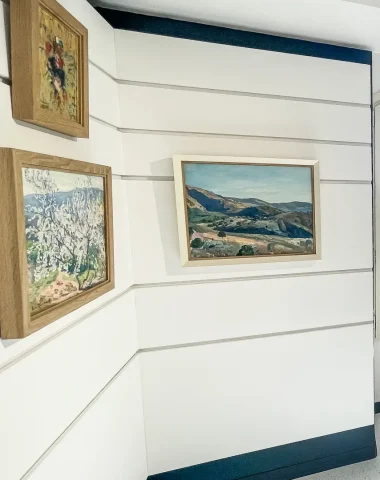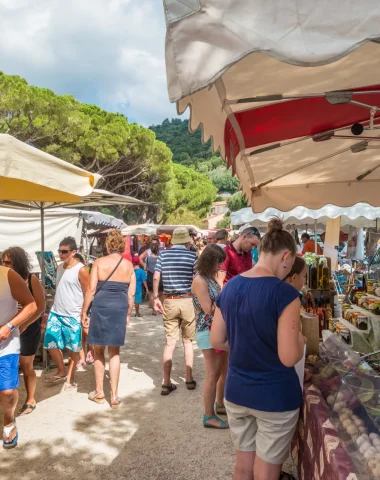Embark on a captivating journey along the Chemin des Sages, a project born from a visionary gathering of the Conseil des Sages, composed of wise individuals aged 60 and above, carefully chosen by local councilors for their wealth of experience. Inspired by the core principles of our Republican motto “Liberté, Égalité, Fraternité,” the council sought to breathe life into these ideals in the town of Bormes.
The Concept Takes Flight
A groundbreaking idea emerged during the council’s meeting—to adorn the town with phrases from renowned men and women, celebrated worldwide for their wisdom and humanism. The goal was to ignite the conscience of both passers-by and tourists, fostering a deeper connection with these universal values. To gain the support of the Mayor and the Council, the decision was made to integrate this pathway with the installation of historical plaques on the town’s iconic monuments. The members of the Conseil des Sages then meticulously designed the route through the medieval village and dedicated themselves to creating the perfect support, texts, images, and symbols for these plaques.

The butterfly, symbolizing joy, beauty, grace, and lightness of being, was chosen as the emblem of the project. Its transformative journey mirrors the essence of personal growth and rebirth. Just like the butterfly, we too experience different stages in life—a profound metamorphosis that allows us to release our past and embrace the beauty of who we’ve become. Symbolizing wisdom, the butterfly becomes a boundless source of inspiration. Beneath its delicate exterior lies an unwavering strength. Despite its ephemeral lifespan of a few days or weeks, the butterfly brings joy and exuberance through its graceful flight, fully savoring every moment that nature presents. Let us, like the butterfly, fearlessly embrace the experiences life offers us, both good and bad, knowing that they are fleeting. After all, our past experiences provide the best preparation for the future, allowing us to tread life’s paths with serenity.
The biography of Condorcet
Enlightenment philosopher, mathematician, economist, editor of the "Encyclopédie", French politician, pioneer of women's right to citizenship.
Nicolas de Condorcet, born on September 17, 1743, in Ribemont (Aisne), was a remarkable figure of the Enlightenment era. He possessed a voracious curiosity that led him to explore various fields, including philosophy and politics. As a mathematician, philosopher, politician, and publisher, he left an indelible mark on French intellectual history.
Condorcet’s notable contributions include his involvement in the famous Encyclopédie, where he played a significant role as an editor. His commitment to the principles of the Enlightenment extended to advocating for the rights of both men and women and vehemently opposing slavery. His dedication to equality was revolutionary for his time, particularly his advocacy for women’s suffrage.

In recognition of his intellectual prowess, Condorcet was appointed Secretary of the Académie des Sciences in 1777 and later became Secretary of the Académie française in 1782. These prestigious positions further cemented his influence and allowed him to shape and contribute to the scientific and literary landscape of France. During the tumultuous years of the French Revolution, Condorcet emerged as a key figure with the hope of reshaping society through reason and rationality. He actively participated in politics and was elected to the Paris City Council. In 1791, he represented Paris at the Legislative Assembly, aligning himself with the Girondins, a political group that sought moderate reforms.
One of Condorcet’s notable endeavors during this time was his proposal for the organization of public education. In April 1792, he presented a report and draft decree to the Assembly, advocating for free, compulsory, secular, and universal education. However, due to the unfolding events of the war and political turmoil, his visionary ideas did not come to fruition until much later, almost a century later.
Condorcet’s commitment to equality extended to his unwavering support for women’s rights. He passionately championed their cause, including their right to vote, an idea far ahead of its time. His progressive and enlightened views made him a target of enmity from those who opposed his ideas.
When the Girondins lost control of the Assembly, Condorcet openly criticized the proposed new Constitution, which led to his condemnation for treason. Faced with the imminent threat of the guillotine, he went into hiding in Paris with Madame Vernet. During this five-month period, he utilized his time to write “Esquisse d’un tableau historique des progrès de l’esprit humain” (“Sketch for a Historical Picture of the Progress of the Human Mind”), a work that anticipated Auguste Comte’s later ideas on positivism.
Feeling unsafe in Paris, Condorcet attempted to flee but was captured in Clamart on March 27. Two days later, rather than facing execution by the guillotine, he tragically chose to take his own life in his prison cell.
Historian Jules Michelet aptly described Condorcet as the “last of the philosophers” of the 18th century. He embodied the spirit of the Enlightenment, with his unwavering belief in the capacity of humanity to progress. Condorcet’s rationalism was rooted in the conviction that education played a pivotal role in advancing society. His visionary ideas on the establishment of a free, secular public education system were far ahead of their time, but they laid the groundwork for future generations and influenced the development of educational systems worldwide.
The clock tower
The Clock Tower, known as the “Tour de l’Horloge,” stands within the village rampart and has an intriguing history. Constructed in 1789, this square tower was specifically built to house a clock. Its height was carefully planned to ensure that the bell’s chimes could be heard from a distance, serving as a time indicator for workers in the fields below and as a warning signal during emergencies like fires in the surrounding hills.
During its construction, the village ramparts were already in a state of disrepair, with some sections destroyed, including near the recently built Saint-Trophyme church in 1783. It is believed that stones from the dilapidated ramparts were reused in constructing new buildings, potentially including the Clock Tower itself. The clock was crafted by Pierre Jobert de Méoune and cost 900 francs, making it the only striking clock in the village at the time.


The bell of the Clock Tower bears the date 1553 and a Latin motto that translates to “Great Wisdom and Judgment of God, have mercy on us.” Adorned with half-reliefs depicting the Virgin and Child, a crucifix, and Saint Michael, the bell measures 0.61 meters in diameter, 0.64 meters in height, and weighs 148 kilograms. It emits the sound of note D. The tower’s external staircases are intricately designed in a spiral shape, constructed with unjointed stones in a fan-like arrangement.
The entrance to the tower, located on Rue Carnot, leads to a room that was once used as a fishmonger’s store. Inside, the tower is mostly empty, except for a narrow spiral staircase that ascends to a platform. The upper room receives light through a north-facing window, and an opening provides access to the top of the tower for maintenance purposes. In 1937, the tower was painted by renowned artist Maurice Utrillo.
The presence of serpentine stones from the La Mole quarry surrounding the door on Rue Carnot indicates the wealth or high social standing of the house’s occupants. Additionally, this location served as a rest house for Carthusian monks from La Verne when they passed through the village, owing to its proximity to places of worship.

To experience the full splendor of the Chemin des Sages and delve deeper into the fascinating stories that unfold along this path, we invite you to explore the Baludik app.
Scan the QR code and embark on an interactive journey filled with games, surprises, and a deeper connection to the rich heritage of Bormes.














